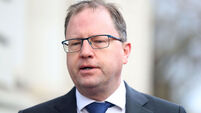Cork council needs to increase spending by €236m to deliver key projects

The county council has been set a new target by the Government to build a minimum of 3,837 new housing units per year between now and 2034. File picture: Dan Linehan
Senior officials are predicting Cork County Council's annual expenditure will rise by a massive €236.5m to €735m by 2029.
The increase in expenditure will reflect the council’s ambitions to build more capital projects, mainly focused on infrastructure investment and major house-building projects.
The council also plans to plough a significant amount of funding into urban regeneration of its towns in the next few years.
Money will also be needed for purchasing land, as the local authority is running out of its own landbanks that are suitable for housing.
The county council has been set a new target by the Government to build a minimum of 3,837 new housing units per year between now and 2034.
It is currently examining the remainder of its landbanks and studying where more can be acquired from private landowners.
In addition, it is looking for developers to submit proposals for housing projects.
If agreement is reached with them, the council will purchase the completed ‘turnkey’ homes that the developers construct.
However, in a detailed report, officials revealed income was not going to keep pace with the expected spending outlays.
Income this year matches expenditure of €516.5m. At present, the prediction for next year is spending of €583.5m, which is €21m more than the likely income.
The gaps increase again in 2027, 2028, and 2029, with expenditure at €639.5m, €696.5, and €735m, while income respectively for those years is predicted at €607.5m, €653m and €700m.
The deficits include factored-in increases. There is a minor increase in rates income from the current €131.1m to €134.5 by 2029.
A larger hike is predicted in central Government grants from the current €236.4m, with incremental increases until 2029 when they reach €356.4m.
Council payroll and pensions currently account for €202.9m of its budget, but are expected to rise to €222.9m by 2029.
Its loan repayments are €15.8m this year, but increased borrowing to achieve targets means they will climb to €35.8m by 2029.
Income from local property tax (LPT) will increase, with a 5% rise next year and for the following three years.
But it will only be a marginal increase per year, with the total take for 2029 estimated as €34.4m, as more houses are built in the region.
Councillors recently agreed with management to increase LPT by 5% for the next four years. It's the first time they have agreed to such a block increase, as previously it was only considered on a yearly basis.
It will bring in an extra €7.6m over that timeframe. Council chief executive Moira Murrell and senior management said they were willing to provide 50% of that revenue directly to the eight municipal district councils to provide them with money they had sought to develop amenities.
Ms Murrell wanted to keep €3.8m in central coffers to help with balancing the council’s overall budget for next year, which will be hammered out in the next few weeks.
However, the councillors voted that down and got 100% of the increase for municipal districts, which has left senior officials trying to cover shortfalls.
This could be addressed by the council upping charges for some of its services and rents for those living in its 8,000-plus social housing units.
In previous years when there were difficulties balancing the books — following the 2008 recession and covid — the council dipped into reserves, which have now dwindled to just €7.8m.





